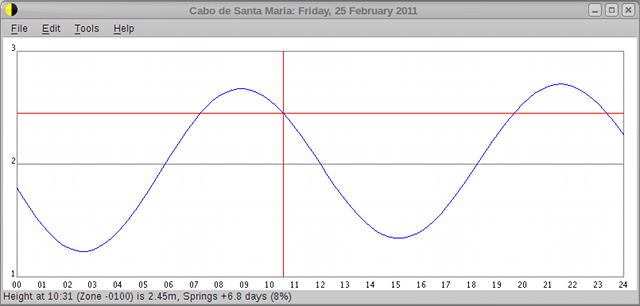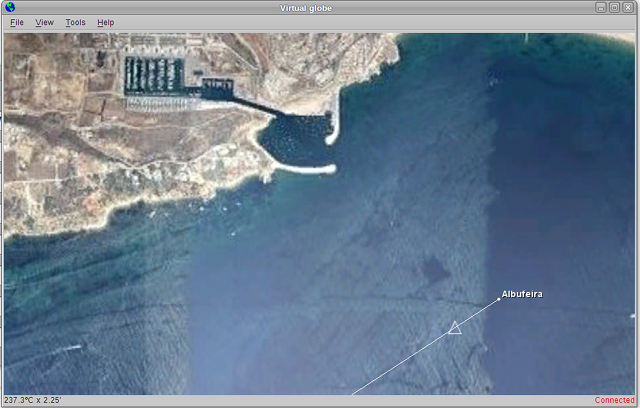Navigate is an integrated set of functions that automate many navigational and tidal calculations which can be time consuming and error prone if performed manually. It can be linked to a GPS to automatically receive position fixes and other information.
Warning: No National Hydrographic Office has verified the information in this product and none accept liability for the accuracy of reproduction or any modifications made thereafter. No National Hydrographic Office warrants that this product satisfies national or international regulations regarding the use of the appropriate products for navigation. Navigate is used to augment conventional methods of navigation or for trip planning. It is not to be used as the sole or primary means of navigation. Prudent navigators use several methods and cross-checks.
Navigate comprises:
Passage navigation - calculates course to steer, ETA, speed over ground, estimated position and distance to go. Calculations take account of course steered, leeway, tidal streams or ocean currents, magnetic variation and deviation. Automatic updates can be provided via connection to a GPS or other NMEA device.
Tidal predictions - draws a daily tidal curve for a port. Depth of water below the keel and depth to be expected on the echo sounder can be calculated for a given charted depth. For anchoring, a recommended scope is given for all-chain cable.
Celestial navigation - calculates a position line and, optionally, a running fix from the Sun and Moon observations.
Virtual globe - plots the current position and the route or track to the destination. Displays weather (Grib) data.
Utilities - calculates distance and bearing between two positions, convert bearings between degrees true, magnetic and compass and calculate the set & drift at a particular position and time.
GPS and NMEA - outputs position, speed, course and waypoint information from a connected GPS or other NMEA compatible device. Waypoints and routes can be transferred to and from most GPSs or other NMEA compatible devices. Displays heading, wind and depth information when connected to NMEA compatible instruments. Navigate uses NMEA 0183, version 1.5 or above.
Automatic passage log.
Automatic screen updates.
Route planning.
Add and amend waypoints, routes, coast outlines (with geographic features) and tidal data.
Built in worldwide ocean currents database.
Built in worldwide magnetic variation model.
Comprehensive help.
Calculation of course to steer, speed over ground, estimated time of arrival, set and drift.
Course corrected for leeway and tidal stream or current.
Multi-leg routes.
Waypoint proximity alert.
Calculation of position line from Sun and Moon sights.
Selection of course by waypoint or latitude and longitude input.
Output display in degrees true, magnetic or compass.
Convert bearings between degrees true, magnetic or compass.
Display of NMEA message data.
Automatic update of course with NMEA data.
Exchange waypoints and routes with Garmin GPSs and NMEA devices.
Worldwide NASA World Wind virtual globe with panning and zooming.
Overlay of waypoints, course, route, weather (Grib) data, geographic features and lines of latitude and longitude.
Run multiple windows (e.g. show one window with complete route and another zoomed on the current leg).
Tidal prediction curves for height at time and time at height at hundreds of British, European, US, Caribbean (Lesser Antilles) and Atlantic island ports.
High and low waters.
Tidal stream at a location.
Save tide table to file.
Calculation of soundings and recommended anchor cable scope.
Run multiple windows (e.g. show one tidal curve at your departure port and another at your destination port).
Java Virtual Machine, SE 6 update 22 or greater.
Graphics card supporting OpenGL or equivalent.
Internet connection to retrieve initial virtual globe data (not needed once data is stored).
Optionally, a GPS or other NMEA compatible devices with NMEA 0183, version 1.5 or above.





Can I add my own tidal streams?
Can I add my own geographic places?
Can I have several windows open at the same time?
Can I skip the “splash” screen at start up?
How long are the tidal predictions valid?
My computer does not have serial port; can I still connect to a GPS?
What machines does Navigate run on?
What text file formats can be imported into Navigate?
Why aren’t the high and low water times for my port the same as my almanac?
Why do I get a warning when I try to add a new route by selecting waypoints from an outline?
Why do I get a warning when I try to import or open a new database file?
Why do I get a warning when I try to start a new route or course?
Why does the Garmin transfer sometimes fail?
Yes, all the required data are published in the Admiralty Tide Tables.
Yes, tidal streams can be taken from your charts or tidal stream atlas.
Yes, they can be entered into the Navigate places database or loaded from a text file.
Yes, you can open multiple outlines and multiple tidal curves from the control panel. Multiple databases can be opened but there is only ever one window per database.
The splash screen is displayed when Navigate is loading data. When this is completed “Ready” is displayed in the status bar at the bottom of the screen. If you click on the screen or press a key the splash screen is dismissed and the control panel is displayed. However, make sure you are familiar with the information on the splash screen.
There are no yearly updates.
Tidal predictions are valid from 31/12/1989 until at least 31/12/2040.
Yes, if your computer has a USB port. You need a USB to serial adaptor with software drivers for your computer.
At present it is only packaged for Ubuntu 10.04 or greater.
Text files need to have tab separated columns with no quotes around the column text. There must be a column even if there is no data present. There must be no duplicate rows. For examples, try exporting to a text file from Navigate and then view it in a standard text editor or import it into a spreadsheet.
Generation of high and low water times depends on the data and algorithms used. Navigate uses the Simplified Harmonic Method and harmonic constants publish by the United Kingdom Hydrographic Office.
This is probably because either the route name or short name is the same as an existing route. Change the name or short name of your new route. (Route and waypoint names and short names must be unique).
Navigate maintains the integrity of the databases. The reference port for a tidal stream datum needs to exist in the ports database. Similarly, all waypoints in a route need to exist in the waypoints database. As an example, you cannot load a waypoints database file if it does not have all the waypoints required by your current routes.
Also, you need to use 'Import text file' to load text files but 'Open' to load existing database files. Make sure you are using the right option for your file.
Normally, this is because you have chosen to apply tidal streams to the course calculations but the required data are not available for your course. You can add the necessary tidal stream data, switch off tidal streams or use ocean currents. Navigate requires tidal stream data at about 20 mile intervals along your course.
The Garmin transfer uses a proprietary protocol that is different from NMEA. Make sure your Garmin GPS is set to Garmin mode and not NMEA made. Check your 'NMEA talker port' and 'NMEA listener port' are set to 'none' on the 'Options' dialog. If you are having problems transferring data with a Garmin GPS then close Navigate, switch off and disconnect your GPS and then re-start.